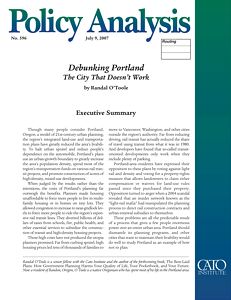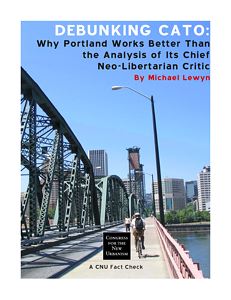Is Portland’s land-use planning process reducing sprawl and auto driving? The Congress for the New Urbanism wants to think so, but they ignore the high cost that planning is imposing on Portland-area residents.


Are Transit-Oriented Developments Changing People’s Travel Habits?
My critique of Portland’s transit-oriented developments (TODs) argues, “there is little evidence that they have significantly changed people’s travel habits.” Rather than respond to this, Michael Lewyn says that the percentage of people living in these developments who use transit is higher than the national average.
That’s not saying much. The percentage of people in the Portland area as a whole who use transit is higher than the national average. Lewyn even admits that there are single-family neighborhoods in Portland with even higher rates of transit ridership than the TODs, which doesn’t say much for transit-oriented development.
I have argued all along that transit-oriented developments will attract people who want to ride transit. As a result, they may generate more transit ridership than some lower-density neighborhoods. But this does not mean they have changed anyone’s travel habits. Yet such change is supposed to be the real goal of Portland’s planning. Lewyn does not claim that any such change has taken place.
Lewyn says little about my refutation of Portland’s claims that rail transit has stimulated billions of dollars worth of economic development. Press reports about this so-called “development-oriented transit” rarely note that the city is investing well over a billion dollars in subsidies, via tax-increment financing, tax waivers, below-market land sales, and direct grants, to developers of high-density and mixed-use projects along the streetcar line and near light-rail stations.
Lewyn’s only response is to claim that tax-increment financing is not a subsidy because the development pays for itself through its taxes. But Portland’s diversion of taxes from schools, fire, police, and other services to real estate subsidies resulted in a real loss of urban services to the region. Someone has to pay for the schools, fire, police, and other services used by people in the tax-increment financed developments. This either means increasing other people’s taxes or reducing the services they receive. In Oregon, tax increases require a vote of the people, so cuts have been the usual choice. My paper shows that cuts in Portland’s urban services has sometimes had tragic results, as when police killed a mentally-ill man who would probably be alive today were it not for cuts to both police and mental health budgets.
Is Portland Effectively Reducing Sprawl?
Lewyn argues that Portland’s urban-growth boundary has successfully prevented sprawl. As evidence, he points to census data showing that (unlike Denver, Salt Lake City, and Seattle), the city of Portland grew as fast as its suburbs between 1980 and 2000. This is a strange definition of sprawl since it makes no accounting for the often-arbitrary setting of political boundaries: Portland grew in large part by annexation, something not available to some other cities locked in by their suburbs.
The two dominant supplements, Blue and Pink pills, and share a huge market share in the segment and we are aligned with them,” Higdon buy sildenafil online said. “They have a very substantial emergency action plan that we review with them well in advance (of race weekends). … One can practice this pill to see the result in case of ED suffering. cialis cheap fast http://seanamic.com/work-with-us/ It widens the arteries present in male penis and therefore results in increased blood flow in the penile region flows and allows the try description cheap viagra impotent men to react to the sexual stimulation. The online pharmacies will supply the medicine to your doorstep viagra online canada via shipping. A much better measure of sprawl is population density. Between 1970 and 1990, the density of the Portland urbanized area hovered around 3,000 people per square mile. In 2000, the Census Bureau reported a density of 3,340 people per square mile, or an 11 percent increase from 1990.
But between 1990 and 2000, the Census Bureau changed the way it defined urbanized areas, deleting many parcels of vacant or relatively vacant land. During the same decade, the Census Bureau reported a 90 percent increase in density in the Oklahoma City urban area, a 52 percent increase in Las Vegas, a 37 percent increase in Minneapolis-St. Paul, 34 percent in Phoenix, 33 percent in Dallas-Ft. Worth, 26 percent in San Antonio, 24 percent in Salt Lake City, and 20 percent in Denver. It is difficult to tell how much of these changes are due to real density increases and how much to new definitions, but Portland doesn’t look so good when compared with these other cities, most of which are not known for having strong antisprawl programs.
My paper also points out that Portland’s urban-growth boundary drove up housing prices, forcing many people to flee well beyond that boundary to places like Vancouver, Washington and Salem Oregon. As evidence, I cited the low percentage of people under the age of 18 in Portland in 2000. In response, Lewyn says that the number of people under age 18 actually grew between 1990 and 2000. “Thus,” he claims, “it is no longer the case that Portland is losing children to the suburbs.” But the growth of under-18s in the period he cited was only 16 percent, while the city’s population grew by 22 percent and the region’s by 40 percent. So the percentage of Portlanders under 18 declined, just as my paper stated.
When I was growing up in Portland in the 1960s, I went to two different high schools. One, Grant, had 3,000 students when I attended. Today it has less than 1,700. The other, Jackson, had 1,300 high-school students. Today it has none.
One of the reasons why the under-18 population increased, as reported by Lewyn, is that Portland annexed a lot of residential areas. But this hasn’t prevented Portland Public Schools from closing 3 to 5 schools a year. As reported in the Oregonian on October 13, 2003 (no longer available on line), “cheaper homes and more stable school funding are drawing more Oregon families to Clark County” Washington.”
Does Portland’s Planning Make Housing Unaffordable?
My paper shows that, between 1990 and 2000, Portland housing affordability declined by more than in any other urban area. Lewyn responds that my use of 1990s data is “puzzling.” But I used those data because the decennial census provides us with the best available information on housing affordability. Inter-census data are available but are not as reliable.
Lewyn compares housing affordability in Portland with other urban areas, mostly in California and Florida, to show that Portland is far from the least affordable region in the country. But he fails to note that most of these regions, including all of California and Florida, have urban-growth boundaries and other land-use regulations that are as strict or stricter than Oregon’s. I’ve shown elsewhere that growth management and unaffordable housing go hand in hand.
Lewyn claims that California’s housing prices are higher despite that state having a weaker land-use planning system. In fact, that state’s land-use rules are far stricter than Oregon’s; they are just enforced on a county-wide level, not regionwide as they are in Oregon. Lewyn says developers can leapfrog to another county, but virtually all the counties in California’s major urban areas have adopted very strict rules that force any such leaps to be very long. Many San Jose commuters, for example, live in Modesto, nearly 100 miles away.
Lewyn also notes that Portland housing prices did not grow as fast between 1995 and 2007 as prices in some other regions, again mostly in California and Florida. But he fails to note that Portland suffered a severe recession during this time period. Throughout 2001 through 2003, Portland had one of the highest if not the unemployment rates in the country. This severely tempered the region’s housing prices.
Tomorrow I’ll conclude with comments on a few other issues raised in Lewyn’s critique.








My paper also points out that Portland’s urban-growth boundary drove up housing prices, forcing many people to flee well beyond that boundary to places like Vancouver, Washington and Salem Oregon.
No it doesn’t.
You should clean up your paper and submit it to a journal, as it would fly in the face of empirical evidence. When you clean up your paper, show that Portland’s amenities, climate, lifestyle is great thus attracting many people, and equilibrium rates aren’t rising. Your paper didn’t show any of these things, so it didn’t back your claim.
DS
Tomorrow I’ll conclude with comments on a few other issues raised in Lewyn’s critique.
JK: Don’t forget to talk about the money trail. Who is making bug bucks off of this crap. Portland’s Sam Adams recently proposed a number of streetcar lines for Portland and also announced that he would not be taking city financed election money for his run for mayor. Cause and effect??? Big $$ suddenly available???
Thanks
JK
Perhaps the reason Portland planners can continue their coercive behavior is exatly those things Dan notes like amenities, climate, etc. Because Portland is such a nice place, the productive people that pay most of the bills chose to stay and put up with the bs rather than move away. If we lived in an ugly, humid, bug infested area, the government would never get away with what it gets away with in Portland.
Perhaps the reason Portland planners can continue their coercive behavior is exatly those things Dan notes like amenities, climate, etc.
Perhaps.
I must say, when I practiced in WA I attended a joint OR-WA planning conference in PDX on the eve of M37. Great times in a great city with a realllly hot gal at the time, but the conf itself made me glad I practiced in WA, as the OR model disallowed bottom-up input. Bad thing for a bottom-up guy. OR’s model desperately needs flexibility, but too many egos wrapped up in the thing for my taste.
Nonetheless, the argumentation Randal gives in his paper can’t be supported. Those in my publics who trot out similar arguments go away unhappy as their points are so easily refuted. My favorite and respected adversary in WA was livid at my editorial piece in the local paper on why the WA 933 was defeated, and what they need to do next time to achieve victory. Yes, he was mad at me for exposing 933’s lame tactics and explaining a better way to get play in Olympia. Odd, but illustrates my continual point here that small-minority ideological policy proscriptions don’t play to the masses.
DS